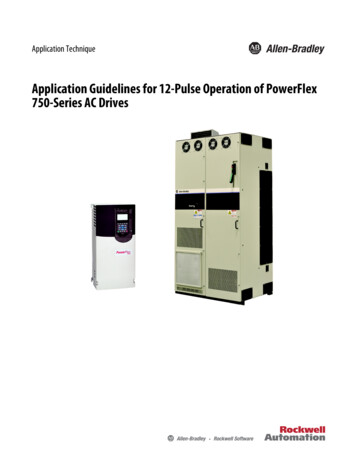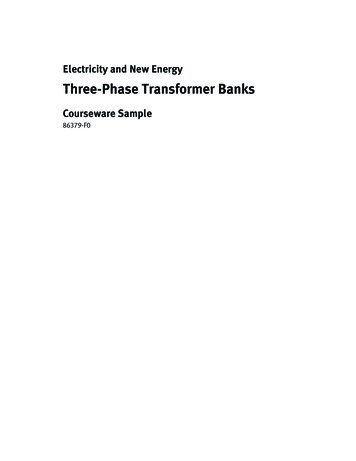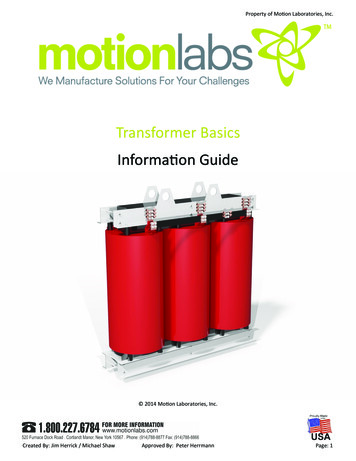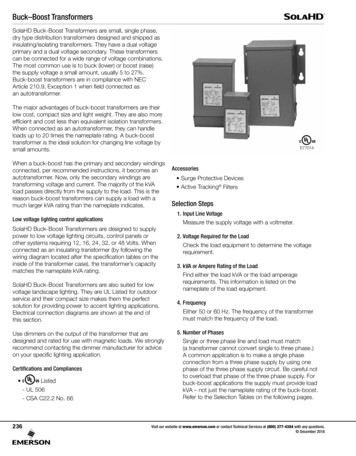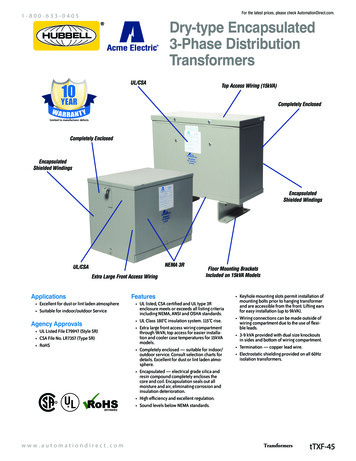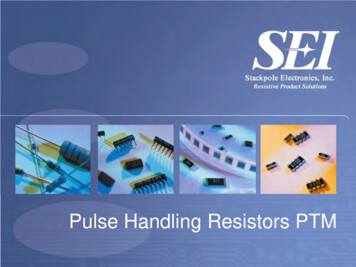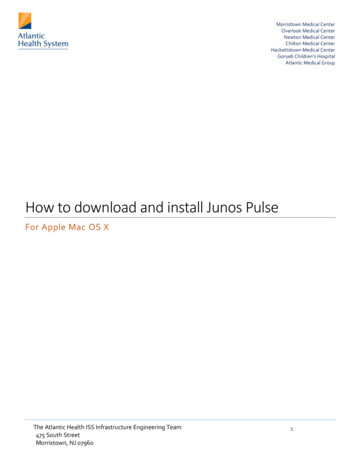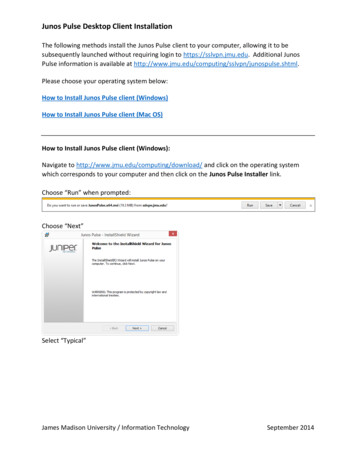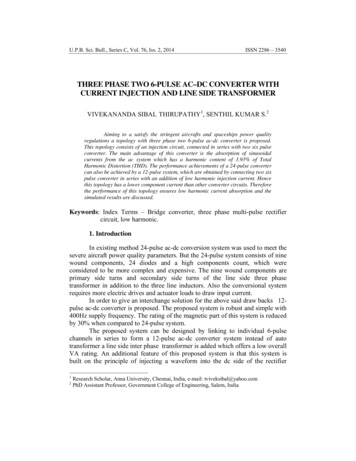
Transcription
U.P.B. Sci. Bull., Series C, Vol. 76, Iss. 2, 2014ISSN 2286 – 3540THREE PHASE TWO 6-PULSE AC–DC CONVERTER WITHCURRENT INJECTION AND LINE SIDE TRANSFORMERVIVEKANANDA SIBAL THIRUPATHY1, SENTHIL KUMAR S.2Aiming to a satisfy the stringent aircrafts and spaceships power qualityregulations a topology with three phase two 6-pulse ac-dc converter is proposed.This topology consists of an injection circuit, connected in series with two six pulseconverter. The main advantage of this converter is the absorption of sinusoidalcurrents from the ac system which has a harmonic content of 3.93% of TotalHarmonic Distortion (THD). The performance achievements of a 24-pulse convertercan also be achieved by a 12-pulse system, which are obtained by connecting two sixpulse converter in series with an addition of low harmonic injection current. Hencethis topology has a lower component current than other converter circuits. Thereforethe performance of this topology ensures low harmonic current absorption and thesimulated results are discussed.Keywords: Index Terms – Bridge converter, three phase multi-pulse rectifiercircuit, low harmonic.1. IntroductionIn existing method 24-pulse ac-dc conversion system was used to meet thesevere aircraft power quality parameters. But the 24-pulse system consists of ninewound components, 24 diodes and a high components count, which wereconsidered to be more complex and expensive. The nine wound components areprimary side turns and secondary side turns of the line side three phasetransformer in addition to the three line inductors. Also the conversional systemrequires more electric drives and actuator loads to draw input current.In order to give an interchange solution for the above said draw backs 12pulse ac-dc converter is proposed. The proposed system is robust and simple with400Hz supply frequency. The rating of the magnetic part of this system is reducedby 30% when compared to 24-pulse system.The proposed system can be designed by linking to individual 6-pulsechannels in series to form a 12-pulse ac-dc converter system instead of autotransformer a line side inter phase transformer is added which offers a low overallVA rating. An additional feature of this proposed system is that this system isbuilt on the principle of injecting a waveform into the dc side of the rectifier12Research Scholar, Anna University, Chennai, India, e-mail: tviveksibal@yahoo.comPhD Assistant Professor, Government College of Engineering, Salem, India
172Vivekananda Sibal Thirupathy, Senthil Kumar S.circuit with the help of an injecting circuit to improve the ac input currents. So theproposed twelve pulse system gives performance characteristics equal to the 24pulse system without using more complex phase shifting devices and additionalrectifier bridges.Therefore the overall system has a low element count and gives a highprotection to the imbalance troubles and this paper deals with the performancecharacteristics and operation of this kind of system with ripple injectiontechnique.2. Converter Description and OperationFig. 1 shows that converter module consists of two three phase six pulsediode rectifiers connected in series, in which one of the rectifiers is supplied fromthe secondary windings of the star delta phase shifting transformer and the otherone is supplied from the primary windings of the transformer. The rectifiers areconsidered to be current fed because of the series inductance of the primarycircuit. Also by the 1:1.732 transformer ratio, the rectifiers can be fed with thesame current. The input currents to the bridge rectifiers are determined by thedifference between the multilevel waveforms and the supply voltage across theline inductors. Practically the transformer leakage inductance is used as the inputinductance and therefore the component count can be reduced.An important feature of any aerospace applications is aiming at thereduced weight. The weight and size of the overall converter can be reduced byfeeding only one of the rectifiers by the primary winding of the transformer.Therefore VA rating of the transformer is only fifty percent of the powerthroughput. This can be achieved by nil galvanic isolation between the input andoutput of the converter and the output voltage cannot be adjusted by thetransformer turns ratio. The dc filter capacitors are big enough to filter out all theoutput current ripples.The analysis can be made easy and understandable by the idealizedwaveforms and the circuit operation without injection. The output current ripplescan be minimized by the dc filter capacitors C1 and C2. The transformer turns ratioof 1.732 can be perfectly achieved by making the transformer magnetizing currentnegligible. The steady state operation can be arrived by considering the circuitcomponents to be ideal.3. Proposed ConverterWhen the current fed rectifiers are connected in series a current mismatchbetween the rectifier outputs will arise and this mismatch can be eliminated byconnecting the midpoint of the output filter capacitors and the common point ofthe series connected rectifiers as shown in the Fig.2, resulting in the flow of
Three phase two 6-pulse AC–DC converter with current injection and line side transformer173current having frequency about six times of the supply frequency between thefilter and the rectifier currents. The source of the rectifiers is a rectified threephase input current, which is having six pulse ripples. This six pulse ripple will beout of phase when two kinds of current source, one formed by the seriesconnection of the primaries and the another one formed by the phase shiftingdevice like star delta transformer having identical mean values. But theinstantaneous values of the above said current sources are not equal and due to thefact a mismatch will be arised. This drawback can be solved by making thedifference current, known as injection current to flow between the capacitors andthe rectifiers. If the connection between the midpoints was reversed, currentmismatch will result in a natural commutation of the rectifier.VRNN RLOA3IiSV1:1.732GVIVoutS2C1IR1 RYIC1BRectifierVIT1Fig. 1. Proposed two six pulse voltage injection converter.The above explained feature can also be used to produce 24-pulse type input linecurrents. These can be clearly elaborated in the following waveforms in the Fig. 3.It shows the current (I1) supplied by the lower rectifier, the current (I2) suppliedby the upper rectifier. The difference current, also known as injection current,between (I1) and (I2) is shown in the Fig. 3 depicts the voltage across the injectionwinding of the voltage injection transformer, represents the output voltage (V01)across the bottom rectifier which is obtained as the addition of the injectionvoltage (Viv) and V0/2.
174Vivekananda Sibal Thirupathy, Senthil Kumar S.Fig. 2. Equivalent circuit of injection circuit.3.1. Injection Circuit OperationThe injection voltage of the injection winding modifies the rectifier outputvoltages V01 and V02 in the following way.VV01 0 V1(1)2VV02 0 V1(2)2When iR1, the output current of rectifier 1, is greater than the iR2, the output currentof rectifier 2, injection voltage become positive and the injection current Ii will benegative. When this negative injection current is flowing through the sensingwinding, the switches 3 and 4 in the Fig. 1 will come to the conduction state andas a result a voltage Vo will be reflected in the injection winding as V0/N, where Nis the injection transformer turns ratio. Therefore the output voltages of the mainrectifier will become:V V 2 V 2 V01 0 0 ;(3)V01 0 1 2 N 2 2 N V 0 V0 2 V 2 ;V02 0 1 N 2 2 2 N As well as when iR1, the output current of rectifier 1, isV02 (4)
Three phase two 6-pulse AC–DC converter with current injection and line side transformer175Fig. 3. Idealized waveforms for the injection circuit.smaller than iR2, the output current of rectifier 2, the injection current Ii reversesand the injection voltage become negative. Finally the phase shift of 300 betweenthe rectifier currents iR1 and iR2 makes the injection current and voltage to have afrequency of six times of the supply frequency. But the injection voltage issmaller than the output voltage by N times and also the RMS value of theinjection current is smaller than the output current and hence the rating of theinjection circuit is small of the order of 2% of the power throughput.3.2. Generating of 24-Pulse WaveformsThe diagram below shows the stepped waveforms of 24-pulse at the righthand side of the inductors. The input voltage waveforms of the lower rectifierwith respect to the mid-point of the output dc link are shown in the first threewaveforms (VRIG, VYIG, and VBIG) of the above figure. When the input currentIR1 is negative, the bottom diode of the R1 leg conducts and the VRIG voltageequals Vo/2 and when the IR1 is positive ,R1 is connected to the positive rail ofrectifier 1,then the voltage VRIG equals the injection voltage V1.The waveformsVYIG and VBIG are identical to VRIG but phase-shifted 1200 and 2400.
176Vivekananda Sibal Thirupathy, Senthil Kumar S.The common mode voltage VNG is calculated using the equation (3) whichis given asVNG (VRIG VYIG VBIG)/3(5)Fig. 4. Production of 24- pulse shows the VRN waveformThe input voltages waveforms VR2G and VB2G to the upper rectifier areshown in the 6th and 7th waveforms of the Fig. 4.When the input current IR2 is positive ,the R2 input terminal is connected to thepositive output of the converter and also the voltage VR2G equals to Vo/2.Whenthe IR2 is negative ,the bottom diode conducts, connecting R2 to the negativeoutput terminal of the upper rectifier. Therefore VR2G becomes equal to the
Three phase two 6-pulse AC–DC converter with current injection and line side transformer177injection voltage V1 and VB2G is identical VR2G and phase shifted 2400 .Next VRR1is calculated by the equation VRR1 (VR2G – VB2G)/1.732 and VRN is described asthe addition of VR1N and VRR1.4. Calculation of the Output VoltageThe fundamental component of the multilevel waveform is determinedbased on the assumption that the converter is designed with the optimum injectiontransformer turns ratio of N 4.07 and from the equation ofVo(6) 00V RN 1 1 . 544The value of equivalent resistor RE, which is connected between the point R andthe supply neutral, N, is determined using the following input –output balanceequation.23V RNV 02 1( rms )(7) R LOADReBy using equation (9) to eliminate VRN-1:Ρε 3ΡΛΟΑΔ2(1.544) 2 0.6292ΡΛΟΑΔ(8)To calculate steady state operating conditions, IR1 is first determined:I R1 VRsNRe jωLsFinally the calculation of V0 was using (6), by allowing calculation of VRN-1.(9)
178Vivekananda Sibal Thirupathy, Senthil Kumar S.(a)(b)Fig 5. (a) and (b) Simulation results of the idealized waveforms for series connection of rectifiers
Three phase two 6-pulse AC–DC converter with current injection and line side transformer5. Simulation Diagram for Two 6-Pulse AC-DC Converter withCurrent InjectionFig. 6. MATLAB simulink model of two 6-pulse ac-dc converter with current injection179
180Vivekananda Sibal Thirupathy, Senthil Kumar S.6. Calculation of THD and Power factorSince the input impedance with fundamental frequency of the uncontrolledconverter consists of the series combination of source resistance Rse and sourceR Loadwill be decreased.inductance LS. The input displacement factorω LsHowever, due to the larger values of Ls, the input current displacement factor ofthe converter will decreased. Input current harmonics are determined byV RN ( Harmonics ). The choice of source inductance LS is to compromiseZ SOURCEbetween reducing the current harmonics, while maintaining the inputdisplacement factor close to unity. It is found that the overall power factor of theR Loadconverter is greater than 0.98 when the ratiois in the region 10 to 100.ω Ls7. Simulation Results for Two 6-Pulse ac-dc Converter With and WithoutCurrent InjectionFig. 7. (a) Input Line current and output voltage with current injectionFig. 7. (b) Input Line current and output voltage without current injection
Three phase two 6-pulse AC–DC converter with current injection and line side transformer(a)Fig. 8. (a) Input voltage and output voltage with current injection(b)Fig. 8. (b) Input voltage and output voltage without current injection181
182Vivekananda Sibal Thirupathy, Senthil Kumar S.Fig. 9. (a) Normalized input line current harmonics with current injectionFig. 9. (b) Normalized input line current harmonics without current injectionFig. 9. (c) Normalized input line voltage harmonics with current injection
Three phase two 6-pulse AC–DC converter with current injection and line side transformer1838. Analysis of Simulation Results and DiscussionOperation of the converter was verified using MATLAB Simulink yconsidered as using ideal components as Fig.6. The parameters are the supply lineto neutral voltage was 115Vrms at the frequency of 400Hz, the assumed inputsource inductors were 115μH and the load resistance was 6Ω. The assumed valueof the source inductance LS is a comparatively large and this is sufficient toproduce a significant phase angle between the line current and supply voltage.From the previous section, by using the procedure of steady statecalculation results in an output voltage of 142V, peak line current of 40A, andphase angle of 12.50 between the fundamental line current and the supply voltage.Fig.7. shows the simulated waveforms of the input source current IR1, andinductor line current IR and Fig.5. shows two six pulse waveform VRR1. Thesimulated results of the output voltage was 141Volts, very close to the determinedvalue and also the peaks of source current IR1, input supply voltage and phaseangle of IR1 and supply voltage are very nearer to the predictions. The totalharmonic distortion (THD) of the source current was calculated to be 3.93% asFig.9 and power factor of the converter is 0.976.9. ConclusionThe proposed converter has totally passive elements and less number ofcomponents and it draws almost sinusoidal current with the THD level of lessthan 5% was presented. The typical performance of this converter is same as the24 pulse system and it based on a current fed two 6-pulse rectifier system withcurrent injection circuit. The analysis of converter, idealized waveforms has beenstudied in this paper and also determined the THD and overall power factor of theconverter was very close to the unity. The injection circuit uses the naturallyoccurring voltage switching waveforms at the output of the rectifiers and injects acurrent that wave-shapes the rectifier output voltages by adding an additionalvoltage level. It can attractive for future aircraft applications.REFERENCES[1].[2].[3].[4].D. R. Trainer and C. R. Whitley, “Electric actuation—Power quality management ofaerospace flight control systems,” in Proc. IEE Power Electron., Machines Drives Conf.,2002, pp. 229–234.E. Matheson and K. Karimi. Power quality specification development for more electricairplane architectures. presented at Soc. Automotive Eng. Power Syst. Conf., Oct. 2002.[CD-ROM]D. A. Paice, Power Electronic Converter Harmonics: Multipulse Methods for Clean Power.New York: IEEE Press, 1995.D. A. Rendusara, A. Von Jouanne, P. N. Enjeti, and D. A. Paice, “Design considerations for12-pulse diode rectifier systems operating under voltage unbalance and pre-existing voltage
184Vivekananda Sibal Thirupathy, Senthil Kumar S.distortion with some corrective measures,” IEEE Trans. Ind. Applicat., vol. 32, no. 6,pp.1293–1303, Nov./Dec. 1996.[5]. F. J. Chivite-Zabalza, A. J. Forsyth, and D. R. Trainer, “Analysis and practical evaluationof an 18-pulse rectifier for aerospace applications,” in Proc. IEE Int. Conf. Power Electron.,Mach. Drives, 2004, pp. 338–343.[6]. D. A. Paice, “Simplified Wye connected three-phase to nine-phase autotransformer,” U.S.Patent 6 525 951, 2003.[7]. P. W. Hammond, “Autotransformer,” U.S. Patent 5 619 407, 1997. C. Niermann, “A neweconomic three-phase PWM inverter for high dynamic feed of induction machines,” inProc. 2nd Eur. Conf. Power Electron. Applicat. (EPE), vol. I, Grenoble, France, 1987, pp.641–646.[8]. M. Depenbrock and C. Niermann, “A new 18-pulse rectifier circuit with line-sideinterphase transformer and nearly sinusoidal line currents,” in Proc. IPEC’90 Conf., Tokyo,Japan, 1990, pp. 539–546.[9]. G. E. April and G. Olivier, “A novel type of 12 pulse converter,” IEEE Trans. Ind.Applicat., vol. IA-21, no. 1, pp. 180–191, Jan./Feb. 1985.[10]. J. F. Baird and J. Arrillaga, “Harmonic reduction in DC-ripple reinjection,” Proc. Inst.Elect. Eng. C, vol. 127, no. 5, pp. 294–55, 1980.11]. J. Arrillaga and M. Villablanca, “A modified parallel HVDC convertor for 24 pulseoperation,” IEEE Trans. Power Delivery, vol. 6, no. 1, pp. 231–237, Jan. 1991.[12]. Y. H. Liu, J. Arrillaga, and N. R. Watson, “Multi-level voltage sourced conversion by voltagere-injection at six times the fundamental frequency,” Proc. Inst. Elect. Eng., vol. 149, no. 3,pp. 201–207, May 2002.[13]. D. R. Trainer, F. J. Chivite, and A. J. Forsyth, “24-Pulse passive multilevel rectifier withharmonic injection,” British patent appl. P105 002GB/SAB, Oct. 24, 2003.[14]. J. Schaefer, Rectifier Circuits, Theory and Design. New York: Wiley, 1965.
Three phase two 6-pulse AC–DC converter with current injection and line side transformer 173 current having frequency about six times of the supply frequency between the filter and the rectifier currents. The source of the rectifiers is a rectified three phase input current, which is having six pulse
